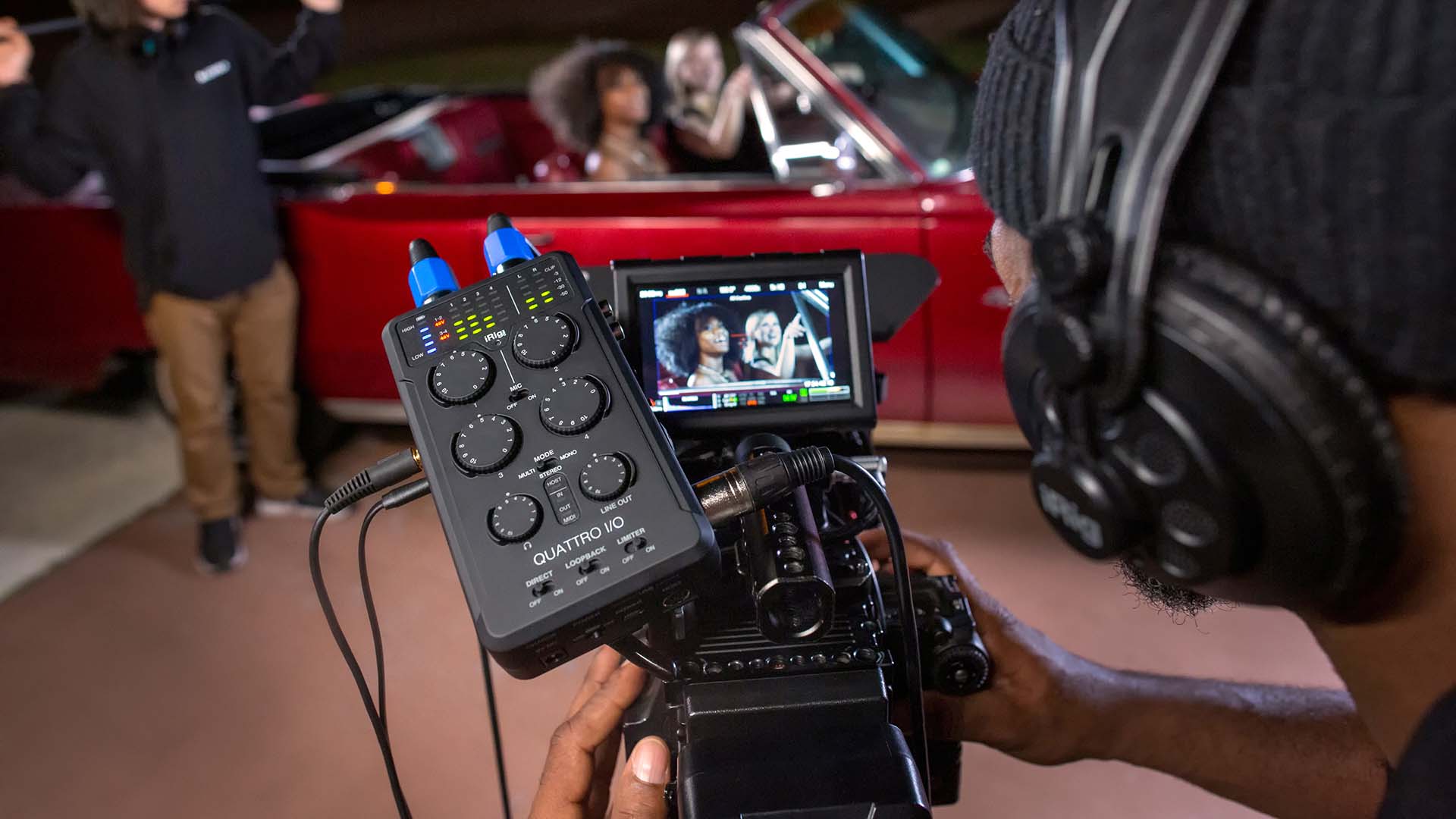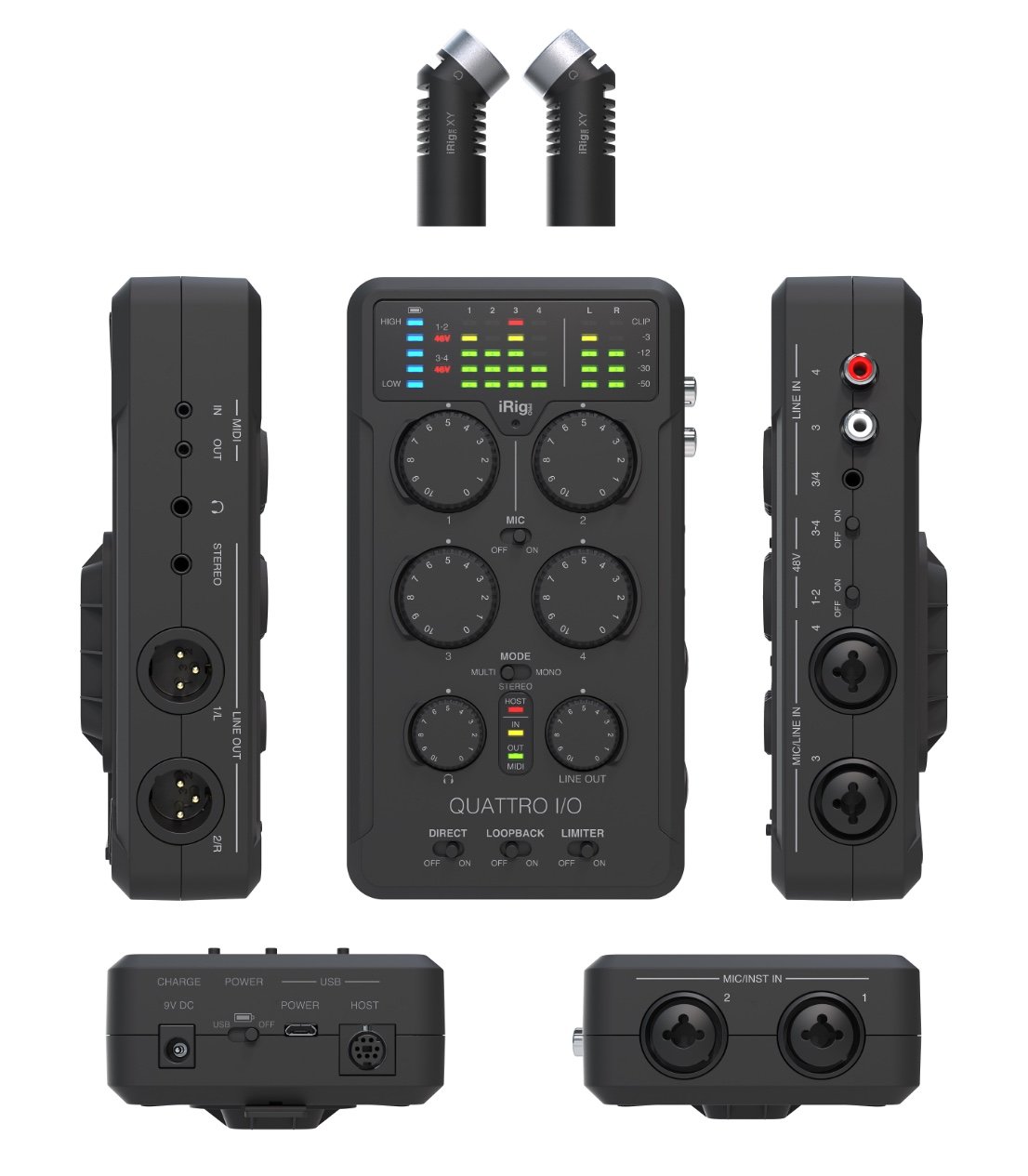
IK Multimedia has started selling its basic iRig Pro Quattro I/O audio interface. The Deluxe version that comes with an XY microphone, a power supply and an accessory bag, will be shipping by the end of June.
The iRig Pro Quattro I/O is a 4-in/2-out portable audio and MIDI interface aimed at field recordists, content creators, live streamers, podcasters and performers. IK Multimedia claims it is a professional-grade device. I put it to the test to find out.
What is “professional-grade” anyway? Does it stand for best possible quality? Or does it mean it’s suitable to make a living with? Regardless, I am happy to say the sound quality of IK Multimedia’s new device is very good. That is not to say I don’t have criticism.
First of all, let’s take a look at some specs of the iRig Pro Quattro I/O. It has a built-in MEMS mic[1]. It’s also a MIDI interface and in tune with IK Multimedia’s tradition, it works seamlessly with an iPhone, iPad (MFi-certified), Android tablet, Mac, and PC.
iRig Pro Quattro specs
Its maximum recording quality is 24-bit, 96kHz sound on four combined XLR / 1/4" mic, guitar, line in ports with phantom power, two RCA, 3.5 mm line in ports, two balanced XLR outs, and a headphone out port with direct monitoring. You can use it as a 4-track, a stereo or a mono recorder. It has live mixing capabilities, a built-in limiter and a safety mode. It connects to your device via USB, and can be powered via a separate USB port, a 9 Volt DC power adapter that comes with the Deluxe version or using battery power (4 AA batteries).

The hardware
The iRig Pro Quattro I/O is made of a type of plastic which is robust enough to withstand daily usage, but if you’re planning on throwing it around, I think you’ll quickly end up with cracks and cuts everywhere.
The device comes with a cleverly designed tripod or mic stand mount. The mounting screw is fitted onto a separate plate that you slide-and-click in place over the battery compartment. It’s safe to use but you could lose the plate if you’re not careful.
The knobs are flat and recessed, which prevents them from breaking easily. Switches are the slide and click type. For example, to switch from mono to stereo, to multi-channel recording, you have one switch with three positions. My experience with an alarm clock that has this type of switch is that frequent use ultimately leads to the click part becoming so fuzzy that you need to use tape to hold it in place at the desired mode. Only time will tell if that is also the case with the iRig Pro Quattro I/O.
The device is equipped with a metering screen at the top and a column of LEDs bottom-center, the latter of which serve to alert you of host, output and MIDI connections. Both screens are made of a rough transparent plastic that won’t scratch nor show grease marks from touching.
Two major grudges I have with all IK Multimedia audio interfaces I tested so far is that the USB power port is micro USB. Why no USB-C? The other grudge is that I can’t understand why connections that have an orientation like XLR combi (Hi-Z and mic capable) ports and micro USB interfaces are upside down.
I could be nitpicking, but I find that very annoying. Try connecting to an upside down XLR port a high-quality Sommer Carbokab 225 mic cable which resembles an oil rig drilling pipe more than it does a signal cable without forcing it into turns…
How well it all works
I first tested the MEMs mic. It’s OK but it takes a loud signal to get a decent recording and it’s not going to make you win awards with its thin sound. It’s good if you’re recording a short statement from someone, but I wouldn’t use it for anything else. The XY mics will be much better if you need to have mics on the device itself.
Four mics (48V phantom powered or not) can be used and three different configurations are possible. You can record all four to individual channels or tracks in a DAW. Using two mics on channels 1 and 2, or four on all channels, you can record stereo with channel 1 and 3, and 2 and 4 mixed to the same track in your DAW. Channel 1 and 2 will be at the gain level you’ve set and the other two are safety (redundant) channels that automatically record at a 12dB lower gain (that’s also the case if you’re only using two mics on channels 1 and 2).
Last but not least, you can record to mono whereby all channels will be summed. Channels 3 and 4 will again serve as safety channels.
If you know in advance your signal will be very loud, then the unit also has a decent limiter on channels 1 and 2 (working both with instruments and mics). Speaking of loudness, I pitted the meters against a pair of Klangshelm VU meters in DIN mode on my Mac and measurements differed by a small margin only.
The device is capable of a 10 Hz to 46 kHz dynamic range. When used with mics, the pre-amps are very silent and there’s little difference with an Apogee Element. There is a distinct difference in “warmth” though, with the iRig Quattro Pro I/O a bit less detailed than the Element 24.
The iRig Pro Quattro I/O is not a recorder, despite the marketing claim you can use it stand-alone. It does not have its own data storage but uses your smartphone or tablet for that, or feeds an on-camera sound system.
Verdict
The device has all the necessary functionality to satisfy a professional while having extra features that will be of much use if you’re only starting out as a sound recordist. The Deluxe version you can pre-order is recommended for its inclusion of XY mics, but it’s currently available for pre-order only at €449.99 excl. VAT. The basic version is available now and retails at €349.99 inc. VAT.
[1] A MEMS microphone is a mic that consists of a pressure-sensitive diaphragm etched behind a stationary perforated plate. The combination acts much like a capacitor of a condenser microphone.


Comments